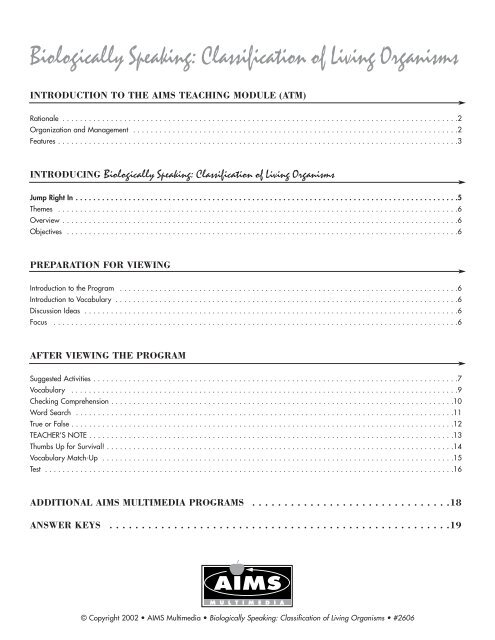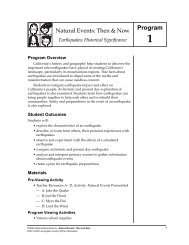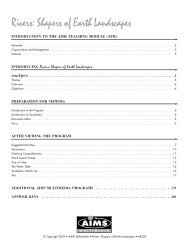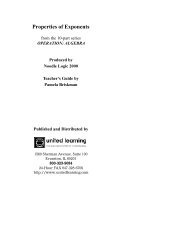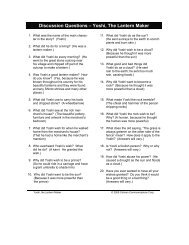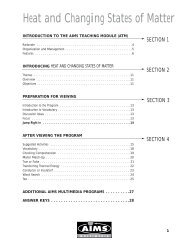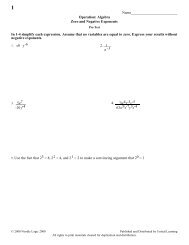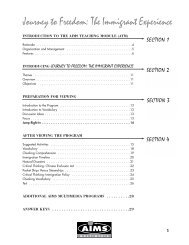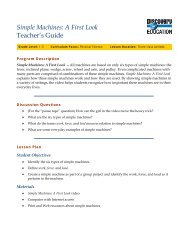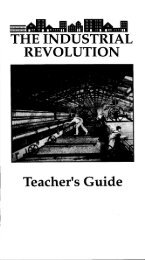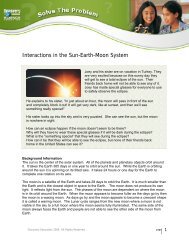Biologically Speaking: Classification of Living Organisms
Biologically Speaking: Classification of Living Organisms
Biologically Speaking: Classification of Living Organisms
Create successful ePaper yourself
Turn your PDF publications into a flip-book with our unique Google optimized e-Paper software.
<strong>Biologically</strong> <strong>Speaking</strong>: <strong>Classification</strong> <strong>of</strong> <strong>Living</strong> <strong>Organisms</strong><br />
INTRODUCTION TO THE AIMS TEACHING MODULE (ATM)<br />
Rationale . . . . . . . . . . . . . . . . . . . . . . . . . . . . . . . . . . . . . . . . . . . . . . . . . . . . . . . . . . . . . . . . . . . . . . . . . . . . . . . . . . . . . . . . . .2<br />
Organization and Management . . . . . . . . . . . . . . . . . . . . . . . . . . . . . . . . . . . . . . . . . . . . . . . . . . . . . . . . . . . . . . . . . . . . . . . . . .2<br />
Features . . . . . . . . . . . . . . . . . . . . . . . . . . . . . . . . . . . . . . . . . . . . . . . . . . . . . . . . . . . . . . . . . . . . . . . . . . . . . . . . . . . . . . . . . . .3<br />
INTRODUCING <strong>Biologically</strong> <strong>Speaking</strong>: <strong>Classification</strong> <strong>of</strong> <strong>Living</strong> <strong>Organisms</strong><br />
Jump Right In . . . . . . . . . . . . . . . . . . . . . . . . . . . . . . . . . . . . . . . . . . . . . . . . . . . . . . . . . . . . . . . . . . . . . . . . . . . . . . . . . . . . . . .5<br />
Themes . . . . . . . . . . . . . . . . . . . . . . . . . . . . . . . . . . . . . . . . . . . . . . . . . . . . . . . . . . . . . . . . . . . . . . . . . . . . . . . . . . . . . . . . . . .6<br />
Overview . . . . . . . . . . . . . . . . . . . . . . . . . . . . . . . . . . . . . . . . . . . . . . . . . . . . . . . . . . . . . . . . . . . . . . . . . . . . . . . . . . . . . . . . . .6<br />
Objectives . . . . . . . . . . . . . . . . . . . . . . . . . . . . . . . . . . . . . . . . . . . . . . . . . . . . . . . . . . . . . . . . . . . . . . . . . . . . . . . . . . . . . . . . .6<br />
PREPARATION FOR VIEWING<br />
Introduction to the Program . . . . . . . . . . . . . . . . . . . . . . . . . . . . . . . . . . . . . . . . . . . . . . . . . . . . . . . . . . . . . . . . . . . . . . . . . . . . .6<br />
Introduction to Vocabulary . . . . . . . . . . . . . . . . . . . . . . . . . . . . . . . . . . . . . . . . . . . . . . . . . . . . . . . . . . . . . . . . . . . . . . . . . . . . . .6<br />
Discussion Ideas . . . . . . . . . . . . . . . . . . . . . . . . . . . . . . . . . . . . . . . . . . . . . . . . . . . . . . . . . . . . . . . . . . . . . . . . . . . . . . . . . . . . .6<br />
Focus . . . . . . . . . . . . . . . . . . . . . . . . . . . . . . . . . . . . . . . . . . . . . . . . . . . . . . . . . . . . . . . . . . . . . . . . . . . . . . . . . . . . . . . . . . . .6<br />
AFTER VIEWING THE PROGRAM<br />
Suggested Activities . . . . . . . . . . . . . . . . . . . . . . . . . . . . . . . . . . . . . . . . . . . . . . . . . . . . . . . . . . . . . . . . . . . . . . . . . . . . . . . . . . .7<br />
Vocabulary . . . . . . . . . . . . . . . . . . . . . . . . . . . . . . . . . . . . . . . . . . . . . . . . . . . . . . . . . . . . . . . . . . . . . . . . . . . . . . . . . . . . . . . .9<br />
Checking Comprehension . . . . . . . . . . . . . . . . . . . . . . . . . . . . . . . . . . . . . . . . . . . . . . . . . . . . . . . . . . . . . . . . . . . . . . . . . . . . . .10<br />
Word Search . . . . . . . . . . . . . . . . . . . . . . . . . . . . . . . . . . . . . . . . . . . . . . . . . . . . . . . . . . . . . . . . . . . . . . . . . . . . . . . . . . . . . .11<br />
True or False . . . . . . . . . . . . . . . . . . . . . . . . . . . . . . . . . . . . . . . . . . . . . . . . . . . . . . . . . . . . . . . . . . . . . . . . . . . . . . . . . . . . . . .12<br />
TEACHER’S NOTE . . . . . . . . . . . . . . . . . . . . . . . . . . . . . . . . . . . . . . . . . . . . . . . . . . . . . . . . . . . . . . . . . . . . . . . . . . . . . . . . . . .13<br />
Thumbs Up for Survival! . . . . . . . . . . . . . . . . . . . . . . . . . . . . . . . . . . . . . . . . . . . . . . . . . . . . . . . . . . . . . . . . . . . . . . . . . . . . . . .14<br />
Vocabulary Match-Up . . . . . . . . . . . . . . . . . . . . . . . . . . . . . . . . . . . . . . . . . . . . . . . . . . . . . . . . . . . . . . . . . . . . . . . . . . . . . . . .15<br />
Test . . . . . . . . . . . . . . . . . . . . . . . . . . . . . . . . . . . . . . . . . . . . . . . . . . . . . . . . . . . . . . . . . . . . . . . . . . . . . . . . . . . . . . . . . . . . .16<br />
ADDITIONAL AIMS MULTIMEDIA PROGRAMS . . . . . . . . . . . . . . . . . . . . . . . . . . . . . . .18<br />
ANSWER KEYS . . . . . . . . . . . . . . . . . . . . . . . . . . . . . . . . . . . . . . . . . . . . . . . . . . . . .19<br />
© Copyright 2002 • AIMS Multimedia • <strong>Biologically</strong> <strong>Speaking</strong>: <strong>Classification</strong> <strong>of</strong> <strong>Living</strong> <strong>Organisms</strong> • #2606
Congratulations!<br />
You have chosen a learning program that will actively motivate your students and provide you with easily accessible and easily manageable<br />
instructional guidelines and tools designed to make your teaching role efficient and rewarding.<br />
The AIMS Teaching Module (ATM) provides you with a video program correlated to your classroom curriculum, instructions and guidelines for<br />
use, plus a comprehensive teaching program containing a wide range <strong>of</strong> activities and ideas for interaction between all content areas. Our<br />
authors, educators, and consultants have written and reviewed the AIMS Teaching Modules to align with the Educate America Act: Goals 2000.<br />
This ATM, with its clear definition <strong>of</strong> manageability, both in the classroom and beyond, allows you to tailor specific activities to meet all <strong>of</strong> your<br />
classroom needs.<br />
RATIONALE<br />
ORGANIZATION AND MANAGEMENT<br />
In today’s classrooms, educational pedagogy is <strong>of</strong>ten founded on<br />
Benjamin S. Bloom’s “Six Levels <strong>of</strong> Cognitive Complexity.” The<br />
practical application <strong>of</strong> Bloom’s Taxonomy is to evaluate students’<br />
thinking skills on these levels, from the simple to the complex:<br />
1. Knowledge (rote memory skills),<br />
2. Comprehension (the ability to relate or retell),<br />
3. Application (the ability to apply knowledge outside its origin),<br />
4. Analysis (relating and differentiating parts <strong>of</strong> a whole),<br />
5. Synthesis (relating parts to a whole)<br />
6. Evaluation (making a judgment or formulating an opinion).<br />
To facilitate ease in classroom manageability, the AIMS Teaching<br />
Module is organized in three sections:<br />
I. Introducing this ATM<br />
will give you the specific information you need to integrate the<br />
program into your classroom curriculum.<br />
II. Preparation for Viewing<br />
provides suggestions and strategies for motivation, language<br />
preparedness, readiness, and focus prior to viewing the program<br />
with your students.<br />
The AIMS Teaching Module is designed to facilitate these intellectual<br />
capabilities, and to integrate classroom experiences and assimilation<br />
<strong>of</strong> learning with the students’ life experiences, realities, and<br />
expectations. AIMS’ learner verification studies prove that our AIMS<br />
Teaching Modules help students to absorb, retain, and to demonstrate<br />
ability to use new knowledge in their world. Our educational<br />
materials are written and designed for today’s classroom, which<br />
incorporates a wide range <strong>of</strong> intellectual, cultural, physical, and<br />
emotional diversities.<br />
III. After Viewing the Program<br />
provides suggestions for additional activities plus an assortment <strong>of</strong><br />
consumable assessment and extended activities, designed to broaden<br />
comprehension <strong>of</strong> the topic and to make connections to other<br />
curriculum content areas.<br />
AIMS Teaching Module written by Pat Davies.<br />
© Copyright 2002 AIMS Multimedia<br />
All Rights Reserved. No part <strong>of</strong> this work may be reproduced or transmitted without written permission <strong>of</strong> AIMS Multimedia with these exceptions: Persons or schools purchasing this<br />
AIMS Teaching Module may reproduce consumable ATM pages, identified in Section 4, for student or classroom use.<br />
AIMS Multimedia is a leading producer and distributor <strong>of</strong> educational programs serving schools and libraries since 1957. AIMS draws upon the most up-to-date knowledge, existing<br />
and emerging technologies, and all <strong>of</strong> the instructional and pedagogical resources available to develop and distribute educational programs in videocassette and CD-ROM.<br />
Persons or schools interested in obtaining additional copies <strong>of</strong> this AIMS Teaching Module, please contact:<br />
AIMS Multimedia at:<br />
Toll Free: 1-800-367-2467<br />
Fax: 818-341-6700<br />
Web: www.aimsmultimedia.com<br />
Email: info@aimsmultimedia.com<br />
2<br />
© Copyright 2002 • AIMS Multimedia • <strong>Biologically</strong> <strong>Speaking</strong>: <strong>Classification</strong> <strong>of</strong> <strong>Living</strong> <strong>Organisms</strong> • #2606
FEATURES<br />
INTRODUCING THE ATM<br />
Your AIMS Teaching Module is designed to<br />
accompany a video program written and<br />
produced by some <strong>of</strong> the world’s most<br />
credible and creative writers and producers<br />
<strong>of</strong> educational programming. To facilitate<br />
diversity and flexibility in your classroom<br />
and to provide assessment tools, your AIMS<br />
Teaching Module features these components:<br />
Themes<br />
This section tells how the AIMS Teaching<br />
Module is correlated to the curriculum.<br />
Themes <strong>of</strong>fers suggestions for interaction<br />
with other curriculum content areas,<br />
enabling teachers to use the teaching<br />
module to incorporate the topic into a<br />
variety <strong>of</strong> learning areas.<br />
Overview<br />
The Overview provides a synopsis <strong>of</strong> content<br />
covered in the video program. Its purpose is<br />
to give you a summary <strong>of</strong> the subject matter<br />
and to enhance your introductory<br />
preparation.<br />
Objectives<br />
The ATM learning objectives provide<br />
guidelines for teachers to assess what<br />
learners can be expected to gain from each<br />
program. After completion <strong>of</strong> the AIMS<br />
Teaching Module, your students will be able<br />
to demonstrate dynamic and applied<br />
comprehension <strong>of</strong>”” the topic.<br />
Preparation for Viewing<br />
In preparation for viewing the video<br />
program, the AIMS Teaching Module <strong>of</strong>fers<br />
activity and/or discussion ideas that you<br />
may use in any order or combination.<br />
Introduction To The Program<br />
Introduction to the Program is designed to<br />
enable students to recall or relate prior<br />
knowledge about the topic and to prepare<br />
them for what they are about to learn.<br />
Introduction To Vocabulary<br />
Introduction to Vocabulary is a review <strong>of</strong><br />
language used in the program: words,<br />
phrases, and usage. This vocabulary<br />
introduction is designed to ensure that all<br />
learners, including limited English<br />
pr<strong>of</strong>iciency learners, will have full<br />
understanding <strong>of</strong> the language usage in the<br />
content <strong>of</strong> the program.<br />
Discussion Ideas<br />
Discussion Ideas are designed to help you<br />
assess students’ prior knowledge about the<br />
topic and to give students a preview <strong>of</strong> what<br />
they will learn. Active discussion stimulates<br />
interest in a subject and can motivate even<br />
the most reluctant learner. Listening, as well<br />
as speaking, is active participation.<br />
Encourage your students to participate at the<br />
rate they feel comfortable. Model sharing<br />
personal experiences when applicable, and<br />
model listening to students’ ideas and<br />
opinions.<br />
Focus<br />
Help learners set a purpose for watching the<br />
program with Focus, designed to give<br />
students a focal point for comprehension<br />
continuity.<br />
Jump Right In<br />
Jump Right In provides abbreviated<br />
instructions for quick management <strong>of</strong> the<br />
program.<br />
After Viewing the Program<br />
After your students have viewed the<br />
program, you may introduce any or all <strong>of</strong><br />
these activities to interact with other<br />
curriculum content areas, provide<br />
reinforcement, assess comprehension skills,<br />
or provide hands-on and in-depth extended<br />
study <strong>of</strong> the topic.<br />
3<br />
© Copyright 2002 • AIMS Multimedia • <strong>Biologically</strong> <strong>Speaking</strong>: <strong>Classification</strong> <strong>of</strong> <strong>Living</strong> <strong>Organisms</strong> • #2606
SUGGESTED ACTIVITIES<br />
The Suggested Activities <strong>of</strong>fer ideas for<br />
activities you can direct in the classroom or<br />
have your students complete independently,<br />
in pairs, or in small work groups after they<br />
have viewed the program. To accommodate<br />
your range <strong>of</strong> classroom needs, the activities<br />
are organized into skills categories. Their<br />
labels will tell you how to identify each<br />
activity and help you correlate it into your<br />
classroom curriculum. To help you schedule<br />
your classroom lesson time, the AIMS<br />
hourglass gives you an estimate <strong>of</strong> the time<br />
each activity should require. Some <strong>of</strong> the<br />
activities fall into these categories:<br />
Meeting Individual Needs<br />
These activities are designed<br />
to aid in classroom continuity.<br />
Reluctant learners and<br />
learners acquiring English<br />
will benefit from these<br />
activities geared to enhance comprehension<br />
<strong>of</strong> language in order to fully grasp content<br />
meaning.<br />
Curriculum Connections<br />
Many <strong>of</strong> the suggested<br />
activities are intended to<br />
ART<br />
integrate the content <strong>of</strong> the<br />
ATM program into other<br />
content areas <strong>of</strong> the<br />
classroom curriculum. These crossconnections<br />
turn the classroom teaching<br />
experience into a whole learning<br />
experience.<br />
Critical Thinking<br />
Critical Thinking activities are<br />
designed to stimulate<br />
learners’ own opinions and<br />
ideas. These activities require students to use<br />
the thinking process to discern fact from<br />
opinion, consider their own problems and<br />
formulate possible solutions, draw<br />
conclusions, discuss cause and effect, or<br />
combine what they already know with what<br />
they have learned to make inferences.<br />
Cultural Diversity<br />
Each AIMS Teaching Module<br />
has an activity called Cultural<br />
Awareness, Cultural Diversity,<br />
or Cultural Exchange that encourages<br />
students to share their backgrounds,<br />
cultures, heritage, or knowledge <strong>of</strong> other<br />
countries, customs, and language.<br />
Hands On<br />
These are experimental or<br />
tactile activities that relate<br />
directly to the material taught<br />
in the program. Your students<br />
will have opportunities to make discoveries<br />
and formulate ideas on their own, based on<br />
what they learn in this unit.<br />
Writing<br />
Every AIMS Teaching Module<br />
will contain an activity<br />
designed for students to use<br />
the writing process to express<br />
their ideas about what they have learned.<br />
The writing activity may also help them to<br />
make the connection between what they are<br />
learning in this unit and how it applies to<br />
other content areas.<br />
In The Newsroom<br />
Each AIMS Teaching Module<br />
contains a newsroom activity<br />
designed to help students make the<br />
relationship between what they learn in the<br />
classroom and how it applies in their world.<br />
The purpose <strong>of</strong> In The Newsroom is to<br />
actively involve each class member in a<br />
whole learning experience. Each student will<br />
have an opportunity to perform all <strong>of</strong> the<br />
tasks involved in production: writing,<br />
researching, producing, directing, and<br />
interviewing as they create their own<br />
classroom news program.<br />
Extended Activities<br />
These activities provide<br />
opportunities for students to<br />
work separately or together to<br />
conduct further research,<br />
explore answers to their own questions, or<br />
apply what they have learned to other<br />
media or content areas.<br />
Link to the World<br />
These activities <strong>of</strong>fer ideas<br />
for connecting learners’<br />
classroom activities to their<br />
community and the rest <strong>of</strong> the world.<br />
Culminating Activity<br />
To wrap up the unit, AIMS<br />
Teaching Modules <strong>of</strong>fer<br />
suggestions for ways to<br />
reinforce what students have<br />
learned and how they can use their new<br />
knowledge to enhance their worldview.<br />
4<br />
© Copyright 2002 • AIMS Multimedia • <strong>Biologically</strong> <strong>Speaking</strong>: <strong>Classification</strong> <strong>of</strong> <strong>Living</strong> <strong>Organisms</strong> • #2606
ADDITIONAL ATM FEATURES<br />
Vocabulary<br />
Every ATM contains an activity that<br />
reinforces the meaning and usage <strong>of</strong> the<br />
vocabulary words introduced in the<br />
program content. Students will read or find<br />
the definition <strong>of</strong> each vocabulary word, then<br />
use the word in a written sentence.<br />
Checking Comprehension<br />
Checking Comprehension is designed to<br />
help you evaluate how well your students<br />
understand, retain, and recall the<br />
information presented in the AIMS Teaching<br />
Module. Depending on your students’ needs,<br />
you may direct this activity to the whole<br />
group yourself, or you may want to have<br />
students work on the activity page<br />
independently, in pairs, or in small groups.<br />
Students can verify their written answers<br />
through discussion or by viewing the video a<br />
second time. If you choose, you can<br />
reproduce the answers from your Answer<br />
Key or write the answer choices in a Word<br />
Bank for students to use. Students can use<br />
this completed activity as a study guide to<br />
prepare for the test.<br />
Reproducible Activities<br />
The AIMS Teaching Module provides a<br />
selection <strong>of</strong> reproducible activities, designed<br />
to specifically reinforce the content <strong>of</strong> this<br />
learning unit. Whenever applicable, they<br />
are arranged in order from low to high<br />
difficulty level, to allow a seamless<br />
facilitation <strong>of</strong> the learning process. You may<br />
choose to have students take these activities<br />
home or to work on them in the classroom<br />
independently, in pairs or in small groups.<br />
Checking Vocabulary<br />
The checking Vocabulary activity provides<br />
the opportunity for students to assess their<br />
knowledge <strong>of</strong> new vocabulary with this word<br />
game or puzzle. The format <strong>of</strong> this<br />
vocabulary activity allows students to use the<br />
related words and phrases in a different<br />
context.<br />
Test<br />
The AIMS Teaching Module Test permits you<br />
to assess students’ understanding <strong>of</strong> what<br />
they have learned. The test is formatted in<br />
one <strong>of</strong> several standard test formats to give<br />
your students a range <strong>of</strong> experiences in testtaking<br />
techniques. Be sure to read, or<br />
remind students to read, the directions<br />
carefully and to read each answer choice<br />
before making a selection. Use the Answer<br />
Key to check their answers.<br />
Additional AIMS Multimedia<br />
Programs<br />
After you have completed this AIMS<br />
Teaching Module you may be interested in<br />
more <strong>of</strong> the programs that AIMS <strong>of</strong>fers. This<br />
list includes several related AIMS programs.<br />
Answer Key<br />
Reproduces tests and work pages with<br />
answers marked.<br />
JUMP RIGHT IN<br />
Preparation<br />
• Read Fire Fighters and Fire Safety for<br />
Kids Themes, Overview, and<br />
Objectives to become familiar with<br />
program content and expectations.<br />
• Use Preparation for Viewing<br />
suggestions to introduce the topic to<br />
students.<br />
Viewing<br />
• Set up viewing monitor so that all<br />
students have a clear view.<br />
• Depending on your classroom size and<br />
learning range, you may choose to<br />
have students view Fire Fighters and<br />
Fire Safety for Kids together or in small<br />
groups.<br />
• Some students may benefit from<br />
viewing the video more than one time.<br />
After Viewing<br />
• Select Suggested Activities that<br />
integrate into your classroom<br />
curriculum. If applicable, gather<br />
materials or resources.<br />
• Choose the best way for students to<br />
work on each activity. Some activities<br />
work best for the whole group. Other<br />
activities are designed for students to<br />
work independently, in pairs, or in<br />
small groups. Whenever possible,<br />
encourage students to share their work<br />
with the rest <strong>of</strong> the group.<br />
• Duplicate the appropriate number <strong>of</strong><br />
Vocabulary, Checking Comprehension,<br />
and consumable activity pages for your<br />
students.<br />
• You may choose to have students take<br />
consumable activities home, or<br />
complete them in the classroom,<br />
independently, or in groups.<br />
• Administer the Test to assess students’<br />
comprehension <strong>of</strong> what they have<br />
learned, and to provide them with<br />
practice in test-taking procedures.<br />
• Use the Culminating Activity as a forum<br />
for students to display, summarize,<br />
extend, or share what they have<br />
learned with each other, the rest <strong>of</strong> the<br />
school, or a local community<br />
organization.<br />
5<br />
© Copyright 2002 • AIMS Multimedia • <strong>Biologically</strong> <strong>Speaking</strong>: <strong>Classification</strong> <strong>of</strong> <strong>Living</strong> <strong>Organisms</strong> • #2606
<strong>Biologically</strong> <strong>Speaking</strong>: <strong>Classification</strong> <strong>of</strong> <strong>Living</strong> <strong>Organisms</strong><br />
Themes<br />
<strong>Biologically</strong> <strong>Speaking</strong>: <strong>Classification</strong> <strong>of</strong><br />
<strong>Living</strong> <strong>Organisms</strong> explores classification<br />
through the seven major levels, from broadest<br />
down to narrowest: kingdom, division<br />
(plants)/phylum (animals), class, order, family,<br />
genus and species. <strong>Organisms</strong>’ cell and<br />
body structure, how they manufacture or<br />
otherwise obtain their food, the ecosystems<br />
they inhabit, their methods <strong>of</strong> reproduction,<br />
and their methods <strong>of</strong> locomotion - if any -<br />
are also covered. <strong>Organisms</strong>’ adaptability<br />
and their almost infinite variety colorfully<br />
illustrate the living population <strong>of</strong> our world.<br />
Overview<br />
There are between two million and four and<br />
a half million different species <strong>of</strong> organisms<br />
living today on Earth. Thousands <strong>of</strong> other<br />
organisms were also alive in the past but are<br />
now extinct. To make it easier to study these<br />
millions <strong>of</strong> organisms, scientists have<br />
grouped them into categories in the organizing<br />
process called classification.<br />
<strong>Classification</strong> breaks all living organisms<br />
down into seven groups. The broadest group<br />
is that <strong>of</strong> the kingdom. Currently, most scientists<br />
recognize a total <strong>of</strong> five kingdoms,<br />
although some believe there may justifiably<br />
be a sixth. Below the kingdom level, the classification<br />
groupings become progressively<br />
narrower, leading to the most precise level,<br />
that <strong>of</strong> the species. Today’s classification system<br />
allows us to efficiently study organisms<br />
from the simplest one-celled beings through<br />
the most complicated <strong>of</strong> vertebrate animals -<br />
the mammals.<br />
Objectives<br />
• To explain the major kingdoms and<br />
how their members are classified<br />
• To illustrate the seven levels <strong>of</strong><br />
classification<br />
• To examine examples from each <strong>of</strong> the<br />
seven classification levels<br />
• To discuss how various plants, animals<br />
and other organisms interact with their<br />
environments<br />
Introduction to the Program<br />
<strong>Biologically</strong> speaking, how are humans classified<br />
What is the correct classification for<br />
the gorilla The program guides students<br />
through the four (out <strong>of</strong> seven) classification<br />
levels that humans and the gorilla have in<br />
common - from the kingdom level down<br />
through order. The two species separate at<br />
the family level. Humans belong to the family<br />
Hominidae, while the gorilla is a member<br />
<strong>of</strong> the family Pongidae. The classification<br />
system can be visually described as an<br />
inverted pyramid. The Kingdoms, at the<br />
wide top <strong>of</strong> the inverted pyramid, are the<br />
broadest classification. The six following levels<br />
become progressively narrower and their<br />
members share more characteristics in common<br />
with one another. The program covers<br />
many <strong>of</strong> the characteristics that organisms at<br />
each level share, such as cell structure, body<br />
structure, food manufacture or procurement,<br />
reproduction, or locomotion.<br />
Introduction to Vocabulary<br />
Write the following words on the board and<br />
explain that they will be referenced in the<br />
video. Some students may be unfamiliar with<br />
the terms. If the meaning <strong>of</strong> any word is<br />
unclear to the group, ask volunteers to use<br />
an appropriate reference source to check the<br />
term and report their findings to the class.<br />
angiosperms, class, division, eukaryotic,<br />
family, genus, gymnosperms, Homo sapiens,<br />
invertebrate, kingdom, nonvascular plants,<br />
order, phylum, primate, prokaryotic,<br />
species, vascular plants, vertebrate<br />
Encourage students to note the context in<br />
which the words are used in the program,<br />
and to be prepared to discuss their meaning.<br />
Discussion Ideas<br />
Ask the class to name as many different classification<br />
groups as they can think <strong>of</strong>, along<br />
with different types <strong>of</strong> living organisms.<br />
Write their suggestions on the board. Have<br />
students arrange any organisms named into<br />
the appropriate group(s). How do the nominated<br />
organisms and groups relate to each<br />
other To which <strong>of</strong> the groups suggested do<br />
humans belong Which group(s) count the<br />
gorilla within their membership The process<br />
<strong>of</strong> organizing living organisms into their scientific<br />
classification groups involves finding<br />
common characteristics among the organisms<br />
- their cell structure, the structure and<br />
function <strong>of</strong> their different parts, their means<br />
<strong>of</strong> nourishment, their method(s) <strong>of</strong> reproduction<br />
or <strong>of</strong> locomotion. It can be a complicated<br />
business, and even scientists may<br />
disagree about how to classify certain<br />
organisms. This program covers classification<br />
into the five kingdoms <strong>of</strong>: Animalia,<br />
Plantae, Fungi, Monera and Protista.<br />
Focus<br />
Ask students to think for a moment about the<br />
importance <strong>of</strong> being able to organize information<br />
in a usable way. Tell them that the<br />
classification system involves the organizing<br />
<strong>of</strong> living organisms into different levels <strong>of</strong><br />
“like” groups so that they can more easily be<br />
identified and studied. Tell them to keep<br />
these thoughts in mind as they view the program.<br />
Let them know you will discuss these<br />
and other aspects <strong>of</strong> classification following<br />
the screening.<br />
6<br />
© Copyright 2002 • AIMS Multimedia • <strong>Biologically</strong> <strong>Speaking</strong>: <strong>Classification</strong> <strong>of</strong> <strong>Living</strong> <strong>Organisms</strong> • #2606
SUGGESTED ACTIVITIES<br />
Critical Thinking<br />
Adaptation is <strong>of</strong>ten the “name <strong>of</strong> the game” in an organism’s survival. Many species <strong>of</strong> mammals, for example,<br />
have made significant physical and behavioral adaptations to survive and reproduce in their environments. Ask<br />
students to think carefully about the following mammalian adaptations and their functions: elephant’s trunk (allows<br />
elephant to reach leaves in tall trees, and to scoop up water for drinking and bathing), beaver’s flat tail (helps<br />
beaver steer when swimming, make noise as a warning, and is used as a stool for sitting), opposable thumb <strong>of</strong><br />
some primates (helps primate grasp items and use tools), and leopard’s spots (camouflage that helps leopard blend<br />
in with its surroundings). Discuss why these adaptations may have occurred and how students think they benefit the<br />
animal.<br />
30 Minutes<br />
Connection to Health and Nutrition<br />
Ask each student to make a list <strong>of</strong> all the ways in which both bacteria and fungi are helpful to humans, and <strong>of</strong> the<br />
ways in which both are harmful. Have them list specific examples <strong>of</strong> each. (Make your own list as students make<br />
theirs.) Review the lists with the class and write the items on the board. Add your own answers to the board if the<br />
students had not also thought <strong>of</strong> them.<br />
HEALTH<br />
40 Minutes<br />
NUTRITION<br />
Critical Thinking<br />
Remind students that in addition to the two to four and a half million species <strong>of</strong> organisms that currently inhabit the<br />
planet, several thousands <strong>of</strong> species that once existed are now extinct. Tell students that although many examples<br />
<strong>of</strong> extinction were caused by specific events or processes (such as humans hunting the passenger pigeon to extinction),<br />
most instances were caused by a failure to adapt to changes in environment. Some scientists and philosophers<br />
say that the “natural selection” process <strong>of</strong> evolution is truly “the survival <strong>of</strong> the fittest.” Discuss with students<br />
what they think the phrase means and how it relates to the survival <strong>of</strong> a species.<br />
15 Minutes<br />
Link to the World<br />
Ask students to look carefully at home, at school, and in the surrounding neighborhoods for a variety <strong>of</strong> kinds <strong>of</strong><br />
living organisms. Have them create lists <strong>of</strong> the organisms they find. Have them classify the organisms at the seven<br />
classification levels: kingdom, division (plants) or phylum (animal), class, order, family, genus and species. Allow<br />
time for students to share their classifications with the class. Discuss their findings and have students develop some<br />
generalizations about the biological community <strong>of</strong> your local ecosystem.<br />
Extended<br />
Connection to Geography/History<br />
Certain gymnosperms - various species <strong>of</strong> evergreen trees - are the largest, oldest plants on Earth. Have students<br />
work individually or in small groups to research such things as the geographic location in which the tallest gymnosperm<br />
trees grow, the height <strong>of</strong> the tallest recorded, the age and species <strong>of</strong> the oldest gymnosperm. Have them<br />
calculate the height ratio between the tallest tree and the tallest building in your community and illustrate it with a<br />
bar graph. Have them draw a timeline that includes the age <strong>of</strong> the oldest known gymnosperm along with historical<br />
events that surround the era in which that tree first sprouted. Ask each group to write a report consolidating<br />
their findings, illustrated with their height ratio bar graph, timeline, and a drawing or photo <strong>of</strong> the tree ring means<br />
<strong>of</strong> dating the age <strong>of</strong> a given tree. Ask for volunteers from each group to present their report to the class.<br />
Extended<br />
GEOGRAPHY<br />
HISTORY<br />
7<br />
© Copyright 2002 • AIMS Multimedia • <strong>Biologically</strong> <strong>Speaking</strong>: <strong>Classification</strong> <strong>of</strong> <strong>Living</strong> <strong>Organisms</strong> • #2606
Link to the World<br />
Tropical rainforests cover less than five percent <strong>of</strong> the planet, yet they are home to more than half the world’s animal<br />
and plant species. In one square mile <strong>of</strong> South American rainforest, scientists have estimated there are as many<br />
as 1,500 species <strong>of</strong> flowering plants, nearly 1,000 species <strong>of</strong> trees, 1,200 species <strong>of</strong> butterflies, and over 1,000<br />
species <strong>of</strong> other animals. Have students work individually or in small groups to select a species <strong>of</strong> living organism<br />
common to tropical rainforests and investigate its current status in that ecosystem. Is it currently stable, increasing<br />
in numbers, decreasing in numbers, endangered Ask students to also research the current status <strong>of</strong> that particular<br />
ecosystem as a whole, and come up with suggestions for stabilizing or improving the viability <strong>of</strong> the tropical<br />
rainforest environment. Ask for volunteers to share their conclusions with the class.<br />
2 Hours<br />
Hands-on Activity<br />
As the video illustrates, members <strong>of</strong> the fungi kingdom can easily spoil fruits and bread. Have students work in<br />
small groups to conduct a simple experiment with fungi. Distribute moist slices <strong>of</strong> bread to half the group, and fresh<br />
slices <strong>of</strong> apple to the rest, with a petri dish or similar container for each. Have each group label their container<br />
and place it in an area <strong>of</strong> the room where it will be undisturbed. Encourage them to observe their containers once<br />
a day for a week. Does mold form on any <strong>of</strong> the bread slices On any <strong>of</strong> the pieces <strong>of</strong> apple If so, what nutrients<br />
do they think mold needs to survive Why When students are done, instruct them to dispose <strong>of</strong> the items properly,<br />
and wash their hands thoroughly. Five sessions, each lasting:<br />
15 Minutes<br />
Connection to Biology<br />
The opposable thumb differentiates humans and some primates from other animals, and is an example <strong>of</strong> a successful<br />
mutation. Have students work in small groups to research mammal evolution at the period during which<br />
opposable thumbs evolved in hominids (anthropoids) and some primates. How would this mutation have assisted<br />
human ancestors and primates in their survival What did it allow individuals to begin doing that they had not<br />
done previously What changes might this adaptation have allowed in various species filling their niches and interacting<br />
with their environments Ask for a volunteer from each group to share their conclusions with the class.<br />
Extended<br />
BIOLOGY<br />
Culminating Activity<br />
Have students work in small groups to create a multi-media presentation using information they’ve learned from<br />
the program. Brainstorm with the class the topics that should be covered, as well as the types <strong>of</strong> materials and<br />
media they would like to include in their presentation. Have each group present to the entire class; you may wish<br />
to set up a school-wide screening so that the class may show their presentations to the entire student population.<br />
Extended<br />
8<br />
© Copyright 2002 • AIMS Multimedia • <strong>Biologically</strong> <strong>Speaking</strong>: <strong>Classification</strong> <strong>of</strong> <strong>Living</strong> <strong>Organisms</strong> • #2606
Name<br />
VOCABULARY<br />
The following words and terms are from <strong>Biologically</strong> <strong>Speaking</strong>: <strong>Classification</strong> <strong>of</strong> <strong>Living</strong> <strong>Organisms</strong>. Read each definition. On the line next to<br />
the definition write the letter <strong>of</strong> the vocabulary word that matches the definition. Then use a separate piece <strong>of</strong> paper to write each word in a<br />
sentence.<br />
A) class<br />
B) division<br />
C) family<br />
D) genus<br />
E) invertebrate<br />
F) kingdom<br />
G) order<br />
H) phylum<br />
I) species<br />
J) vertebrate<br />
1. ________ the second most specific classification level<br />
2. ________ classification level that comes between class and family<br />
3. ________ an organism that has a segmented backbone<br />
4. ________ the broadest classification category into which organisms are grouped<br />
5. ________ a grouping <strong>of</strong> organisms that resemble each other and that are capable <strong>of</strong> reproducing to create fertile <strong>of</strong>fspring<br />
6. ________ an animal that does not have a spine<br />
7. ________ the second highest and second broadest classification level for plants and fungi<br />
8. ________ the second broadest classification grouping for animals<br />
9. ________ organism grouping that falls between phylum or division and order<br />
10. ________ classification level between genus and order<br />
9<br />
© Copyright 2002 • AIMS Multimedia • <strong>Biologically</strong> <strong>Speaking</strong>: <strong>Classification</strong> <strong>of</strong> <strong>Living</strong> <strong>Organisms</strong> • #2606
Name<br />
CHECKING COMPREHENSION<br />
Answer the following questions. Use a separate sheet <strong>of</strong> paper if necessary.<br />
1. What are the seven major levels in the classification <strong>of</strong> living organisms<br />
2. What is the broadest level <strong>of</strong> classification<br />
3. What is the narrowest level <strong>of</strong> classification<br />
4. What are the genus and species names for human beings<br />
5. Bacteria are single-celled organisms that are described as _________________________.<br />
6. Because they contain chlorophyll, euglena are capable <strong>of</strong> making their own food through _________________________.<br />
7. Fungi are plant-like organisms which cannot make their own food because they do not have _________________________.<br />
8. Fungi get their food from _________________________ or from _________________________.<br />
9. Plants that have specialized cells that carry food and water throughout the organism are called _________________________.<br />
10. How do coelenterates obtain their prey<br />
11. About 75% <strong>of</strong> all animals belong to the phylum _________________________.<br />
12. What differentiates the two classes <strong>of</strong> fish from one another<br />
13. Amphibians are a class <strong>of</strong> vertebrates that can live in and out <strong>of</strong> _________________________.<br />
14. What feature shows the reptilian origins <strong>of</strong> birds<br />
15. The most advanced <strong>of</strong> the vertebrates are the class _________________________. Some features that distinguish the members <strong>of</strong> this class<br />
include _________________________.<br />
10<br />
© Copyright 2002 • AIMS Multimedia • <strong>Biologically</strong> <strong>Speaking</strong>: <strong>Classification</strong> <strong>of</strong> <strong>Living</strong> <strong>Organisms</strong> • #2606
Name<br />
WORD SEARCH<br />
Read each vocabulary definition below. On the line before each definition write the appropriate word, then find each in the word search. Look<br />
up, down, across, backwards and diagonally to find the words.<br />
Z X G C B X V D W Q M K S L S<br />
D I V I S I O N G W Q Z E V P<br />
C C N V W H J W Q P Y B T J E<br />
WORD BANK<br />
class<br />
division<br />
family<br />
genus<br />
Homo sapiens<br />
invertebrate<br />
kingdom<br />
order<br />
phylum<br />
primates<br />
species<br />
vertebrate<br />
K J M V L C T T B N X V A V C<br />
S M Y Y E W B V K H E J M K I<br />
W U W Z X R X Z V R K M I J E<br />
H L N H Z C T H T J R N R H S<br />
B Y W E W V R E S K G K P J J<br />
T H T V G W B W B D M M N R R<br />
W P W C H R V V O R D E R C W<br />
S X X Z A C H M K L A Q Q V K<br />
S L K T H H B D D R Z T K B L<br />
A Z E Z Y L I M A F W W E Q P<br />
L G C C X G S S K K C V G G Z<br />
C Z X H O M O S A P I E N S X<br />
______________________<br />
______________________<br />
______________________<br />
______________________<br />
______________________<br />
______________________<br />
______________________<br />
______________________<br />
______________________<br />
______________________<br />
______________________<br />
the order <strong>of</strong> mammals that includes humans, apes, monkeys and prosimians<br />
an animal that does not have a spine<br />
the second most specific classification level<br />
an organism that has a segmented backbone<br />
the broadest classification category into which organisms are grouped<br />
our species: human beings<br />
classification level that comes between class and family<br />
a grouping <strong>of</strong> organisms that resemble each other and that are capable <strong>of</strong> reproducing to create fertile <strong>of</strong>fspring<br />
classification level between genus and order<br />
the second highest and second broadest classification level for plants and fungi<br />
organism grouping that falls between phylum or division and order<br />
______________________ the second broadest classification grouping for animals<br />
11<br />
© Copyright 2002 • AIMS Multimedia • <strong>Biologically</strong> <strong>Speaking</strong>: <strong>Classification</strong> <strong>of</strong> <strong>Living</strong> <strong>Organisms</strong> • #2606
Name<br />
TRUE OR FALSE<br />
Place a T next to statements that are true and an F next to statements that are false.<br />
1. ________ The classification levels, from the narrowest to the broadest, are kingdom, class, family, order, division/phylum, genus, species.<br />
2. ________ Members <strong>of</strong> the Phylum Chordata have backbones.<br />
3. ________ Human beings have hair and produce milk for their young and are in the Class Mammalia.<br />
4. ________ The Plantae and Animalia kingdoms include large numbers <strong>of</strong> simple single-celled organisms.<br />
5. ________ Eukaryotic cells have a distinct nucleus and other distinct structures within their cell membrane.<br />
6. ________ Cyanobacteria are a major source <strong>of</strong> food and oxygen for animal life in lakes and ponds.<br />
7. ________ Pneumonia and tuberculosis are potentially fatal diseases caused by parasitic fungi.<br />
8. ________ Euglena move by extending their pseudopods.<br />
9. ________ The drug penicillin is derived from fungi.<br />
10. ________ Evergreen trees, such as pines, fir and spruce are Gymnosperms.<br />
12<br />
© Copyright 2002 • AIMS Multimedia • <strong>Biologically</strong> <strong>Speaking</strong>: <strong>Classification</strong> <strong>of</strong> <strong>Living</strong> <strong>Organisms</strong> • #2606
TEACHER’S NOTE<br />
The following exercise, THUMBS UP FOR SURVIVAL!, requires students to work in two-person teams using the following materials:<br />
MATERIALS LIST<br />
• 2 THUMBS UP FOR SURVIVAL! worksheets per team<br />
• Rolls <strong>of</strong> tape OR 2 large rubber bands per team<br />
• 1 magazine per team - or circulate 1 magazine amongst the teams<br />
• 1 plastic bottle OR paper cup per student<br />
• 1 box <strong>of</strong> tissues - distribute 1 tissue per student<br />
• 1 WRAPPED cookie OR WRAPPED piece <strong>of</strong> candy per student<br />
IN ADDITION, TEAMS WILL REQUIRE<br />
Access to computer or typewriter<br />
1 comb OR hairbrush per student (students’ own items)<br />
If any <strong>of</strong> the above items are unavailable, that aspect <strong>of</strong> the exercise may be eliminated, or substitute a similar task <strong>of</strong> the students’ choosing.<br />
Students’ results on this exercise should spark a discussion on the influence that mutations can have on a species’ survival and its ability to<br />
thrive.<br />
13<br />
© Copyright 2002 • AIMS Multimedia • <strong>Biologically</strong> <strong>Speaking</strong>: <strong>Classification</strong> <strong>of</strong> <strong>Living</strong> <strong>Organisms</strong> • #2606
Name<br />
THUMBS UP FOR SURVIVAL!<br />
Humans and some primates have opposable thumbs. This was a very successful mutation that helped individual primates, and early humans,<br />
to survive and thrive. It was passed down to succeeding generations. Having always had thumbs, it’s difficult for us as individuals to think how<br />
we might cope without this useful digit. To understand how important your thumbs are in everyday life, team up with a classmate to complete<br />
this exercise.<br />
Have your classmate use tape or large rubber bands to loosely fasten your thumbs to the side <strong>of</strong> your hands by your index finger. Then read<br />
over the tasks listed in the table below. Do your best to accomplish each task with your “thumbless” hands. Your partner can make notes as to<br />
how you do on each one. When you have finished, trade places and make notes as to how your classmate does on the tasks.<br />
Tasks Can’t Do Extremely Difficult Moderately Difficult Simple<br />
Pick up a magazine<br />
Write the word “thumb”<br />
Drink from a plastic bottle<br />
or paper cup<br />
Draw a picture<br />
Type 2 sentences at the<br />
computer<br />
Brush or comb you hair<br />
Unwrap a cookie or candy<br />
(provided by your teacher)<br />
Tie or untie your shoe<br />
Use a tissue and PRETEND<br />
to blow your nose<br />
14<br />
© Copyright 2002 • AIMS Multimedia • <strong>Biologically</strong> <strong>Speaking</strong>: <strong>Classification</strong> <strong>of</strong> <strong>Living</strong> <strong>Organisms</strong> • #2606
Name<br />
VOCABULARY MATCH UP<br />
Draw a line from the vocabulary words on the left to their correct definitions on the right.<br />
A) angiosperms<br />
1. our species: human beings<br />
B) eukaryote<br />
2. the group <strong>of</strong> seed-bearing plants whose seeds grow inside <strong>of</strong> cones; representatives <strong>of</strong> this group<br />
include evergreen tress such a pine, fir and spruce<br />
C) gymnosperms<br />
3. the order <strong>of</strong> mammals that includes humans, apes, monkeys and prosimians<br />
D) Homo sapiens<br />
4. plants that do not have water-and-food conducting tissues<br />
E) nonvascular plants<br />
5. cell or single-celled organism that has nuclear material but does not have a distinct nucleus or other<br />
distinct subcellular structures<br />
F) primates<br />
6. one <strong>of</strong> the two major types <strong>of</strong> seed-bearing plants; these have flowers<br />
G) prokaryote<br />
7. plants that have tissues that carry water and food to all parts <strong>of</strong> the organism<br />
H) vascular plants<br />
8. cell with a distinct nucleus and other distinct structures within the cell membrane<br />
15<br />
© Copyright 2002 • AIMS Multimedia • <strong>Biologically</strong> <strong>Speaking</strong>: <strong>Classification</strong> <strong>of</strong> <strong>Living</strong> <strong>Organisms</strong> • #2606
Name<br />
TEST<br />
Circle the letter <strong>of</strong> the correct answer for multiple-choice questions. Write a one-sentence answer for questions that are not multiple choice.<br />
1. The process scientists have used to group categories <strong>of</strong> living organisms is called (insert blank).<br />
A) nomenclature<br />
B) classification<br />
C) taxation<br />
2. Human beings are in the Kingdom (insert blank).<br />
A) Chordata<br />
B) Animalia<br />
C) Plantae<br />
3. Animals that have backbones are in the Phylum (insert blanks).<br />
A) Invertebrata<br />
B) Mammalia<br />
C) Chordata<br />
4. In what two ways do euglena get food<br />
5. One type <strong>of</strong> fungi gets its nourishment from other living organisms. What is this type <strong>of</strong> fungi known as<br />
6. Name the two broad categories <strong>of</strong> plants.<br />
7. Ferns have a life cycle known as the “alternation <strong>of</strong> generations.” To what does this phrase refer<br />
8. What types <strong>of</strong> seed plants are discussed in the program<br />
9. What one body structure characterizes all members <strong>of</strong> Phylum Arthropoda<br />
10. To produce their <strong>of</strong>fspring, various species <strong>of</strong> reptiles (insert blank)<br />
A) lay eggs on land<br />
B) lay eggs in water<br />
C) give birth to live young<br />
D) A and C<br />
16<br />
© Copyright 2002 • AIMS Multimedia • <strong>Biologically</strong> <strong>Speaking</strong>: <strong>Classification</strong> <strong>of</strong> <strong>Living</strong> <strong>Organisms</strong> • #2606
Name<br />
TEST (CONTINUED)<br />
11. A major adaptation that separates birds from their reptilian ancestors is that most <strong>of</strong> their scales modified into (insert blank).<br />
A) gills<br />
B) fur<br />
C) feathers<br />
12. An animal that is warm-blooded, covered with hair or fur, and that has mammary glands that produce milk is a/an (insert blank).<br />
A) amphibian<br />
B) mammal<br />
C) parasite<br />
13. The first vertebrates were (insert blank).<br />
A) dinosaurs<br />
B) amphibians<br />
C) fish<br />
14. Young amphibians hatch (insert blank) and breathe (insert blank).<br />
A) in water; through gills<br />
B) at night; through lungs<br />
C) twice; occasionally<br />
15. Almost all mammals (insert blank).<br />
A) can fly<br />
B) give birth to live young<br />
C) are hairless<br />
17<br />
© Copyright 2002 • AIMS Multimedia • <strong>Biologically</strong> <strong>Speaking</strong>: <strong>Classification</strong> <strong>of</strong> <strong>Living</strong> <strong>Organisms</strong> • #2606
ADDITIONAL AIMS MULTIMEDIA PROGRAMS<br />
You and your students might also enjoy these other AIMS Multimedia programs:<br />
9080-EN-VID: <strong>Classification</strong>: Bringing Order to Diversity<br />
2601 <strong>Biologically</strong> <strong>Speaking</strong>: Genetics and Heredity<br />
2605 <strong>Biologically</strong> <strong>Speaking</strong>: <strong>Living</strong> Cells<br />
18<br />
© Copyright 2002 • AIMS Multimedia • <strong>Biologically</strong> <strong>Speaking</strong>: <strong>Classification</strong> <strong>of</strong> <strong>Living</strong> <strong>Organisms</strong> • #2606
ANSWER KEY for page 9<br />
VOCABULARY<br />
The following words and terms are from <strong>Biologically</strong> <strong>Speaking</strong>: <strong>Classification</strong> <strong>of</strong> <strong>Living</strong> <strong>Organisms</strong>. Read each definition. On the line next to<br />
the definition write the letter <strong>of</strong> the vocabulary word that matches the definition. Then use a separate piece <strong>of</strong> paper to write each word in a<br />
sentence.<br />
A) class<br />
B) division<br />
C) family<br />
D) genus<br />
E) invertebrate<br />
F) kingdom<br />
G) order<br />
H) phylum<br />
I) species<br />
J) vertebrate<br />
1. ________ D the second most specific classification level<br />
2. ________ G classification level that comes between class and family<br />
3. ________ J an organism that has a segmented backbone<br />
4. ________ F the broadest classification category into which organisms are grouped<br />
5. ________ I a grouping <strong>of</strong> organisms that resemble each other and that are capable <strong>of</strong> reproducing to create fertile <strong>of</strong>fspring<br />
6. ________ E an animal that does not have a spine<br />
7. ________ B the second highest and second broadest classification level for plants and fungi<br />
8. ________ H the second broadest classification grouping for animals<br />
9. ________ A organism grouping that falls between phylum or division and order<br />
10. ________ C classification level between genus and order<br />
19<br />
© Copyright 2002 • AIMS Multimedia • <strong>Biologically</strong> <strong>Speaking</strong>: <strong>Classification</strong> <strong>of</strong> <strong>Living</strong> <strong>Organisms</strong> • #2606
ANSWER KEY for page 10<br />
CHECKING COMPREHENSION<br />
Answer the following questions. Use a separate sheet <strong>of</strong> paper if necessary.<br />
1. What are the seven major levels in the classification <strong>of</strong> living organisms (kingdom, phylum (animals) or division (plants, fungi), class, order,<br />
family, genus and species)<br />
2. What is the broadest level <strong>of</strong> classification (kingdom)<br />
3. What is the narrowest level <strong>of</strong> classification (species)<br />
4. What are the genus and species names for human beings (genus: Homo; species: sapiens)<br />
5. Bacteria are single-celled organisms that are described as (prokaryotic).<br />
6. Because they contain chlorophyll, euglena are capable <strong>of</strong> making their own food through (photosynthesis).<br />
7. Fungi are plant-like organisms which cannot make their own food because they do not have (chlorophyll).<br />
8. Fungi get their food from (dead organic matter) or from (other living organisms).<br />
9. Plants that have specialized cells that carry food and water throughout the organism are called (vascular plants).<br />
10. How do coelenterates obtain their prey (They use stinging tentacles to capture and immobilize their prey.)<br />
11. About 75% <strong>of</strong> all animals belong to the phylum (Arthropoda).<br />
12. What differentiates the two classes <strong>of</strong> fish from one another (The bony fishes have skeletons made <strong>of</strong> bones; the other class <strong>of</strong> fish have<br />
skeletons made <strong>of</strong> cartilage, such as sharks or rays.)<br />
13. Amphibians are a class <strong>of</strong> vertebrates that can live in and out <strong>of</strong> (water).<br />
14. What feature shows the reptilian origins <strong>of</strong> birds (the scales that cover their legs)<br />
15. The most advanced <strong>of</strong> the vertebrates are the class (Mammalia). Some features that distinguish the members <strong>of</strong> this class include (They are<br />
warm-blooded, have four-chambered hearts, are covered with fur or hair, and have mammary glands that produce milk for their young.<br />
Almost all mammals give birth to live young; some mammals like kangaroos have protective pouches in which <strong>of</strong>fspring mature until they<br />
can survive on their own).<br />
20<br />
© Copyright 2002 • AIMS Multimedia • <strong>Biologically</strong> <strong>Speaking</strong>: <strong>Classification</strong> <strong>of</strong> <strong>Living</strong> <strong>Organisms</strong> • #2606
ANSWER KEY for page 11<br />
WORD SEARCH<br />
Read each vocabulary definition below. On the line before each definition write the appropriate word, then find each in the word search. Look<br />
up, down, across, backwards and diagonally to find the words.<br />
Z X G C B X V D W Q M K S L S<br />
D I V I S I O N G W Q Z E V P<br />
C C N V W H J W Q P Y B T J E<br />
WORD BANK<br />
class<br />
division<br />
family<br />
genus<br />
Homo sapiens<br />
invertebrate<br />
kingdom<br />
order<br />
phylum<br />
primates<br />
species<br />
vertebrate<br />
K J M V L C T T B N X V A V C<br />
S M Y Y E W B V K H E J M K I<br />
W U W Z X R X Z V R K M I J E<br />
H L N H Z C T H T J R N R H S<br />
B Y W E W V R E S K G K P J J<br />
T H T V G W B W B D M M N R R<br />
W P W C H R V V O R D E R C W<br />
S X X Z A C H M K L A Q Q V K<br />
S L K T H H B D D R Z T K B L<br />
A Z E Z Y L I M A F W W E Q P<br />
L G C C X G S S K K C V G G Z<br />
C Z X H O M O S A P I E N S X<br />
primates<br />
______________________<br />
invertebrate<br />
______________________<br />
genus<br />
______________________<br />
vertebrate<br />
______________________<br />
kingdom<br />
______________________<br />
Homo sapiens<br />
______________________<br />
order<br />
______________________<br />
species<br />
______________________<br />
family<br />
______________________<br />
division<br />
______________________<br />
class<br />
______________________<br />
phylum<br />
______________________<br />
the order <strong>of</strong> mammals that includes humans, apes, monkeys and prosimians<br />
an animal that does not have a spine<br />
the second most specific classification level<br />
an organism that has a segmented backbone<br />
the broadest classification category into which organisms are grouped<br />
our species: human beings<br />
classification level that comes between class and family<br />
a grouping <strong>of</strong> organisms that resemble each other and that are capable <strong>of</strong> reproducing to create fertile <strong>of</strong>fspring<br />
classification level between genus and order<br />
the second highest and second broadest classification level for plants and fungi<br />
organism grouping that falls between phylum or division and order<br />
the second broadest classification grouping for animals<br />
21<br />
© Copyright 2002 • AIMS Multimedia • <strong>Biologically</strong> <strong>Speaking</strong>: <strong>Classification</strong> <strong>of</strong> <strong>Living</strong> <strong>Organisms</strong> • #2606
ANSWER KEY for page 12<br />
TRUE OR FALSE<br />
Place a T next to statements that are true and an F next to statements that are false.<br />
1. ________ F The classification levels, from the narrowest to the broadest, are kingdom, class, family, order, division/phylum, genus, species.<br />
2. ________ T Members <strong>of</strong> the Phylum Chordata have backbones.<br />
3. ________ T Human beings have hair and produce milk for their young and are in the Class Mammalia.<br />
4. ________ F The Plantae and Animalia kingdoms include large numbers <strong>of</strong> simple single-celled organisms.<br />
5. ________ T Eukaryotic cells have a distinct nucleus and other distinct structures within their cell membrane.<br />
6. ________ T Cyanobacteria are a major source <strong>of</strong> food and oxygen for animal life in lakes and ponds.<br />
7. ________ F Pneumonia and tuberculosis are potentially fatal diseases caused by parasitic fungi.<br />
8. ________ F Euglena move by extending their pseudopods.<br />
9. ________ T The drug penicillin is derived from fungi.<br />
10. ________ T Evergreen trees, such as pines, fir and spruce are Gymnosperms.<br />
22<br />
© Copyright 2002 • AIMS Multimedia • <strong>Biologically</strong> <strong>Speaking</strong>: <strong>Classification</strong> <strong>of</strong> <strong>Living</strong> <strong>Organisms</strong> • #2606
ANSWER KEY for page 14<br />
THUMBS UP FOR SURVIVAL!<br />
Humans and some primates have opposable thumbs. This was a very successful mutation that helped individual primates, and early humans,<br />
to survive and thrive. It was passed down to succeeding generations. Having always had thumbs, it’s difficult for us as individuals to think how<br />
we might cope without this useful digit. To understand how important your thumbs are in everyday life, team up with a classmate to complete<br />
this exercise.<br />
Have your classmate use tape or large rubber bands to loosely fasten your thumbs to the side <strong>of</strong> your hands by your index finger. Then read<br />
over the tasks listed in the table below. Do your best to accomplish each task with your “thumbless” hands. Your partner can make notes as to<br />
how you do on each one. When you have finished, trade places and make notes as to how your classmate does on the tasks.<br />
Students’ results will vary. When the members <strong>of</strong> all teams have finished, use their results as the basis for a group discussion.<br />
Tasks Can’t Do Extremely Difficult Moderately Difficult Simple<br />
Pick up a magazine<br />
Write the word “thumb”<br />
Drink from a plastic bottle<br />
or paper cup<br />
Draw a picture<br />
Type 2 sentences at the<br />
computer<br />
Brush or comb you hair<br />
Unwrap a cookie or candy<br />
(provided by your teacher)<br />
Tie or untie your shoe<br />
Use a tissue and PRETEND<br />
to blow your nose<br />
23<br />
© Copyright 2002 • AIMS Multimedia • <strong>Biologically</strong> <strong>Speaking</strong>: <strong>Classification</strong> <strong>of</strong> <strong>Living</strong> <strong>Organisms</strong> • #2606
ANSWER KEY for page 15<br />
VOCABULARY MATCH UP<br />
Draw a line from the vocabulary words on the left to their correct definitions on the right.<br />
A) angiosperms<br />
1. our species: human beings<br />
B) eukaryote<br />
2. the group <strong>of</strong> seed-bearing plants whose seeds grow inside <strong>of</strong> cones; representatives <strong>of</strong> this group<br />
include evergreen tress such a pine, fir and spruce<br />
C) gymnosperms<br />
3. the order <strong>of</strong> mammals that includes humans, apes, monkeys and prosimians<br />
D) Homo sapiens<br />
4. plants that do not have water-and-food conducting tissues<br />
E) nonvascular plants<br />
5. cell or single-celled organism that has nuclear material but does not have a distinct nucleus or other<br />
distinct subcellular structures<br />
F) primates<br />
6. one <strong>of</strong> the two major types <strong>of</strong> seed-bearing plants; these have flowers<br />
G) prokaryote<br />
7. plants that have tissues that carry water and food to all parts <strong>of</strong> the organism<br />
H) vascular plants<br />
8. cell with a distinct nucleus and other distinct structures within the cell membrane<br />
24<br />
© Copyright 2002 • AIMS Multimedia • <strong>Biologically</strong> <strong>Speaking</strong>: <strong>Classification</strong> <strong>of</strong> <strong>Living</strong> <strong>Organisms</strong> • #2606
ANSWER KEY for page 16<br />
TEST<br />
Circle the letter <strong>of</strong> the correct answer for multiple-choice questions. Write a one-sentence answer for questions that are not multiple choice.<br />
1. The process scientists have used to group categories <strong>of</strong> living organisms is called (insert blank).<br />
A) nomenclature<br />
B) classification<br />
C) taxation<br />
2. Human beings are in the Kingdom (insert blank).<br />
A) Chordata<br />
B) Animalia<br />
C) Plantae<br />
3. Animals that have backbones are in the Phylum (insert blanks).<br />
A) Invertebrata<br />
B) Mammalia<br />
C) Chordata<br />
4. In what two ways do euglena get food<br />
They can produce food through photosynthesis and can also absorb food from the environment.<br />
5. One type <strong>of</strong> fungi gets its nourishment from other living organisms. What is this type <strong>of</strong> fungi known as<br />
This type <strong>of</strong> fungi is a parasite.<br />
6. Name the two broad categories <strong>of</strong> plants.<br />
vascular plants and nonvascular plants<br />
7. Ferns have a life cycle known as the “alternation <strong>of</strong> generations.” To what does this phrase refer<br />
This refers to ferns’ two stage method <strong>of</strong> reproduction - a sexual stage and an asexual stage.<br />
8. What types <strong>of</strong> seed plants are discussed in the program<br />
gymnosperms and angiosperms<br />
9. What one body structure characterizes all members <strong>of</strong> Phylum Arthropoda<br />
their exoskeleton<br />
10. To produce their <strong>of</strong>fspring, various species <strong>of</strong> reptiles (insert blank)<br />
A) lay eggs on land<br />
B) lay eggs in water<br />
C) give birth to live young<br />
D) A and C<br />
25<br />
© Copyright 2002 • AIMS Multimedia • <strong>Biologically</strong> <strong>Speaking</strong>: <strong>Classification</strong> <strong>of</strong> <strong>Living</strong> <strong>Organisms</strong> • #2606
ANSWER KEY for page 17<br />
TEST (CONTINUED)<br />
11. A major adaptation that separates birds from their reptilian ancestors is that most <strong>of</strong> their scales modified into (insert blank).<br />
A) gills<br />
B) fur<br />
C) feathers<br />
12. An animal that is warm-blooded, covered with hair or fur, and that has mammary glands that produce milk is a/an (insert blank).<br />
A) amphibian<br />
B) mammal<br />
C) parasite<br />
13. The first vertebrates were (insert blank).<br />
A) dinosaurs<br />
B) amphibians<br />
C) fish<br />
14. Young amphibians hatch (insert blank) and breathe (insert blank).<br />
A) in water; through gills<br />
B) at night; through lungs<br />
C) twice; occasionally<br />
15. Almost all mammals (insert blank).<br />
A) can fly<br />
B) give birth to live young<br />
C) are hairless<br />
26<br />
© Copyright 2002 • AIMS Multimedia • <strong>Biologically</strong> <strong>Speaking</strong>: <strong>Classification</strong> <strong>of</strong> <strong>Living</strong> <strong>Organisms</strong> • #2606


